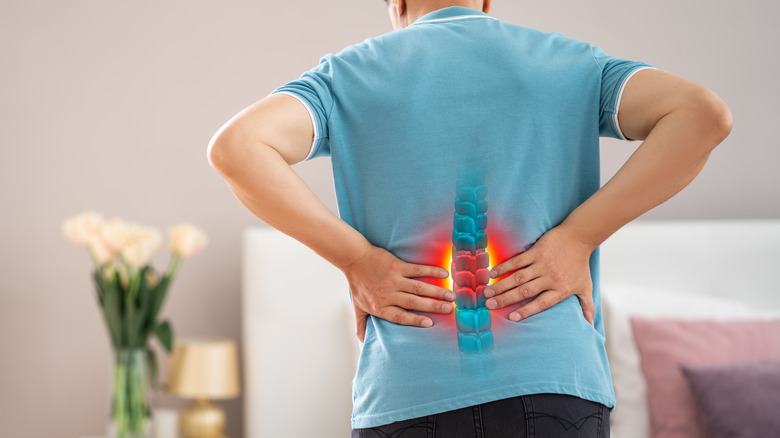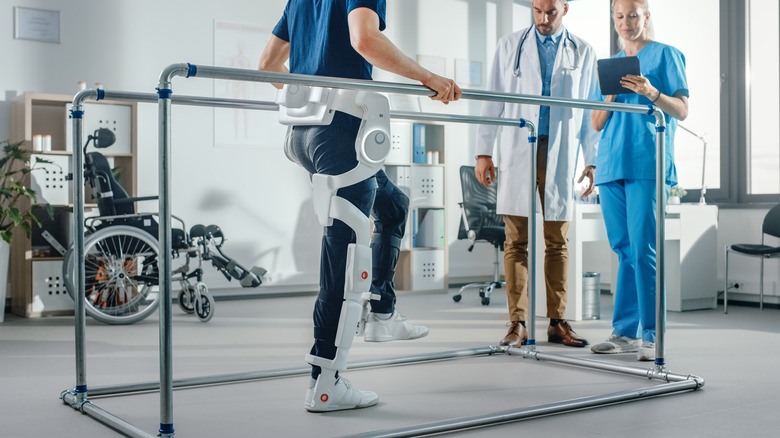Everything You Should Know About Chronic Pain
Chronic pain could affect as many as 20.4% of Americans, based on data from the 2019 National Health Interview Survey (via the CDC). The data also suggest that 7.4% of Americans said that chronic pain "frequently limited life or work activities" (which they refer to as "high-impact chronic pain").
On the other hand, anywhere from 11-40% of Americans live with chronic pain, meaning the actual number could be much higher (per Neuroscience Specialists). Of course, the experience of pain is subjective, according to a review from the Annals of Agricultural and Environmental Medicine. Chronic pain is notoriously difficult to measure, in part because it requires the use of survey data; however, these numbers are high enough to cause alarm. As pointed out by Neuroscience Specialists, these are epidemic levels, and many consider chronic pain in America to be an epidemic.
The CDC further explains that chronic pain is one of the most common reasons people seek medical care, and it is associated with worse mental health outcomes and quality of life. Additionally, women were more likely than men to report experiencing chronic pain, and chronic pain levels were also higher among those living in rural areas (as opposed to urban areas) as well as the elderly. With chronic pain affecting so many people, it's a good idea to learn more about it.
What is chronic pain?
How is chronic pain defined? According to the Cleveland Clinic, chronic pain refers to any sort of pain that lasts more than three months. Chronic pain is distinct from acute pain in that acute pain is temporary, typically resulting from an injury. For instance, a cut or even a broken bone could cause acute pain, but not necessarily chronic pain. Per WebMD, a broken bone takes an average of 6-8 weeks to heal, generally not long enough to surpass three months. Of course, depending on the fracture, some broken bones could cause chronic pain if not fully healed after more than three months. Osteoporosis Canada says this process could take up to a few years, during which time chronic pain would likely be experienced.
But chronic pain can result from many other things apart from bone fractures that take a while to heal. Chronic pain could be a sign of a variety of health conditions, including mental health conditions. For instance, depression can create chronic pain. As Healthline explains, depression can cause back pain, muscle aches, headaches, stomach aches, and even a decreased tolerance for pain (meaning levels of pain that were once tolerable could become unendurable). Thus, depression and other mental health issues can cause the same physical chronic pain as many other health conditions.
Pain is a protective mechanism, but chronic pain can be debilitating
The experience of pain may be unpleasant or even unbearable, but there's a reason it exists.
As a review from the Annals of Agricultural and Environmental Medicine explains, pain is a protective mechanism used by the body to alert us to a harmful stimulus. It is the most common symptom of any disease. The authors further clarify that pain is a "subjective sensory and emotional experience" and felt differently by each person, making it very complicated to quantify and study. They also describe the process by which we feel pain, which itself is complicated. The experience of pain depends on a variety of factors, among them the strength of the "harmful stimulus" as well as our tolerance and history of pain. Sometimes, pain results from irritation of our pain receptors, but the authors point out that pain can also be felt even when our pain receptors haven't been activated (which they refer to as psychogenic pain). Per the review, the subjective experience of pain is determined by the central nervous system response.
Another study from the Journal of Pain and Palliative Care Pharmacotherapy reinforces this point: Chronic pain can trigger the fight-or-flight response of the central nervous system, causing additional stress as a secondary response to the pain.
Chronic pain is a symptom of many conditions
A review from the Annals of Agricultural and Environmental Medicine suggests that pain is the most common symptom associated with disease. More specifically, chronic pain can be a symptom of a wide variety of health conditions. Healthline lists some potential causes of chronic pain, but keep in mind that any list is likely to be incomplete. The list includes some chronic noncommunicable diseases like cancer and arthritis. Additionally, they mention headaches, lower back pain, pain following trauma or surgery, nerve damage, and psychogenic pain (pain that isn't caused by physical injury) as common causes of chronic pain.
Apart from these potential causes, WebMD lists diseases, congenital conditions, and obesity as common causes of chronic pain. Additionally, lifestyle habits such as sleeping on an uncomfortable mattress, wearing high heels, poor posture, and poor form while lifting or carrying heavy items may also be potential causes of chronic pain.
Chronic pain can be caused by many conditions, but it can also cause further health complications itself. A review from Pain Medicine suggests chronic pain negatively impacts many other aspects of a person's health, such as sleep, mental health, cognitive function, cardiovascular function, sexual function, and quality of life. The researchers consider chronic pain to be a chronic disease of its own: They advocate for defining it as a neurological disease.
Frequent headaches are a form of chronic pain
One of the most common experiences of chronic pain is frequent headaches. Data from the WHO suggests 1.7-4% of adults worldwide experience headaches 15 or more days per month. According to the Cleveland Clinic, this is one symptom of "chronic migraine." When someone experiences headaches at least 15 days out of the month and migraines at least 8 days of the month, this is referred to as chronic migraine if it lasts for at least three months. JAMA estimates as many as 10% of people worldwide experience migraines (but not all of these people have chronic migraine).
A migraine is essentially a very severe headache. The Mayo Clinic says it can cause throbbing pain or pulsing sensations, often on just one side of the head. Migraines also frequently occur alongside nausea, vomiting, and heightened sensitivity to light and noise. Like headaches, migraines can have many causes, but it isn't clear why some people experience migraines while others don't. (By contrast, nearly everyone experiences headaches, according to the WHO.) Among those who do experience migraines, certain triggers can potentially cause them: alcohol, caffeine, stress, hormonal changes, weather changes, foods, medications, external stimuli, etc.
Another important factor is dehydration. A study from the journal Headache estimates as many as 10% of headaches may be caused by dehydration. If you regularly experience headaches or migraines, it's important to figure out what your personal triggers are.
Back pain is one of the most common types of chronic pain
Approximately 39% of Americans experience back pain, according to survey data from Statista. The survey measured pain prevalence in different parts of the body and found back pain to be the most commonly reported type of pain. Another article from Statista states that 54% of those reporting back or neck pain have had this pain for five years or longer, meaning a majority of people reporting back pain are experiencing it as chronic pain. Another survey found that 29% of those with back pain blamed stress, 26% believed it was due to weakness and lack of exercise, and 26% said it was because of physical work.
According to Spine Health, back pain can have a variety of causes. Most commonly, lower back pain can happen as a result of injury, strain, or sprain, but it can also be caused by other things, like certain conditions or a history of poor posture. WebMD suggests that the posture we tend to adopt while using our smartphones and tablets puts our health at risk and is potentially a major contributor to health problems associated with poor posture. If you're concerned about back or neck pain, working on your posture — for all activities but especially while using mobile devices — can help considerably.
Injury can cause chronic pain
Another major cause of chronic pain is injury. The Cleveland Clinic defines chronic pain as pain lasting longer than three months, so any injury that takes longer than three months to heal has the potential to cause chronic pain.
Healthline suggests that chronic pain is most often caused by an initial injury (such as a pulled muscle or a back sprain), and having an injury is a major risk factor for developing chronic pain. Additionally, pain can sometimes linger after an injury heals, meaning injuries could lead to chronic pain in more than one way. For instance, chronic pain could result from nerve damage, which could happen as the result of an injury — but nerve damage would cause lasting pain after the injury heals. This is partly because nerves are involved in the perception of pain.
That said, the pain caused by nerve damage tends to feel different than other types of pain. Nerve pain, or neuralgia, is often described as a "shooting, stabbing, or burning sensation," according to Health Direct Australia. Nerve pain can be caused by a variety of things, but one of the most common causes is injury.
Some chronic diseases can cause chronic pain
Chronic diseases and other health conditions often lead to chronic pain. Healthline lists a variety of conditions that can lead to chronic pain, including cancer, arthritis, chronic fatigue syndrome, fibromyalgia, endometriosis, inflammatory bowel disease (IBS), interstitial cystitis, and more. Note that some of these conditions are not well understood, and we don't always know the underlying causes of any such condition.
For instance, fibromyalgia is the name we give to the condition that causes widespread pain all over the body. As the CDC points out, the cause is not known, but as many as 2% of Americans may suffer from fibromyalgia. We do know it is associated with lupus and arthritis, two additional health conditions that can each cause chronic pain on their own. The CDC also suggests fibromyalgia can potentially develop as a result of traumatic events, injuries, or other illnesses.
Chronic fatigue syndrome is another condition we don't completely understand. The Mayo Clinic defines it as a disorder causing excessive exhaustion that can't be explained by a pre-existing medical condition. When extreme fatigue happens for more than six months and we can't find a cause, we call it chronic fatigue syndrome. Viral infections, problems with the immune system, hormonal imbalances, and trauma could all potentially contribute to the development of chronic fatigue syndrome.
Stomach disorders can cause chronic pain
The GI Alliance claims 62 million Americans (roughly 19%) are diagnosed with a digestive order every year. Additionally, the group attributes 25% of all surgeries to digestive diseases, pointing out that more Americans are hospitalized for digestive problems than for any other condition. Of these digestive diseases, colorectal cancer is one of the most common, and it is the second most common cause of cancer death. The experts at the GI Alliance lists diet, sleep, stress, and smoking as major risk factors for developing digestive disorders, though they also suggest such disorders have a hereditary component — and the underlying causes of many of these diseases are still unknown.
A review from Digestive Diseases says digestive disorders can lead to chronic abdominal pain, seriously affecting a person's quality of life. The researchers suggest that a majority of those who report chronic abdominal pain have a functional disorder such as irritable bowel syndrome (IBS). In the case of IBS, the primary cause is not known, according to the Mayo Clinic. However, early life trauma, changes in the gut microbiome, nervous system abnormalities, and severe infection could all be potential causes of IBS. Certain types of food can also act as triggers for IBS, so it's important for those who have IBS to figure out what their trigger foods are.
Anxiety and depression can cause chronic pain
The etiology of chronic pain may not necessarily be physical, but it always has physical effects. Mental health issues such as anxiety and depression can cause physical pain. As Harvard Health explains, research has shown that the biological mechanisms of pain overlap with the biological mechanisms of anxiety and depression. In fact, it's not always clear which is really the root cause: Depression can create physical pain, but physical pain can also cause depression, potentially creating a vicious cycle.
Considerable evidence demonstrates that depression can lead to chronic pain. According to the National Headache Foundation, mild tension headaches can result from depression. A study from the Journal of the Canadian Chiropractic Association also shows that depression is associated with lower back pain. Additionally, Harvard Health says that depression can be both a cause and a symptom of digestive problems.
As a study from the Journal of Pain and Palliative Care Pharmacotherapy asserts, "anxiety and depression often coexist with chronic pain." The study also suggests that the sympathetic nervous system is involved in the experience of pain, and the fight-or-flight response can be activated in response to pain. In other words, pain can cause stress, but stress can also cause pain. The Cleveland Clinic claims stress can both lower our tolerance for pain and also cause additional pain itself, potentially leading to things like sore muscles or flare-ups of any chronic conditions we already have (such as fibromyalgia).
Lifestyle changes can help with chronic pain
Chronic pain can be debilitating, but it can also respond to treatment. Per the Cleveland Clinic, the treatment of chronic pain will depend on a variety of factors, such as age, other health conditions, the cause of the pain (if known), and the type of pain. Lifestyle changes can help to alleviate chronic pain, and they have no side effects, making them a great low-risk option for treatment. In fact, the lifestyle changes that can help improve chronic pain are known to improve overall health more broadly, so they may have additional benefits. The Cleveland Clinic recommends focusing on stress management, light exercise (to the extent that it's possible depending on the type of chronic pain), getting enough sleep, and eating a healthy diet.
It's easy to see how these changes could benefit other areas of life. For instance, as Harvard Health explains, the effects of your diet are far-reaching. A diet high in antioxidant-rich food like whole fruits and vegetables, nuts, whole grains, and legumes provides protection against inflammation and disease. Meanwhile, evidence suggests an unhealthy diet could harm the immune system as much as a bacterial infection, according to a study from the journal Cell. The researchers explain that the so-called Western diet — high in fast food and other ultra-processed foods — may be misinterpreted by our immune system as a threat, triggering an unnecessary immune response which, over time, could lead to excess inflammation.
Physical therapy can help improve chronic pain
When chronic pain limits the use of specific muscles or a certain area of the body, physical therapy may be a good option. For instance, a review from the Journal of Athletic Training suggests that core stability training (a form of physical therapy targeting the core) improves lower back pain more effectively than general exercise. Of course, general exercise can still improve lower back pain, but the idea is that physical therapy exercises can be tailored to whichever part of the body is in pain, improving the experience of pain more so than exercise alone.
As WebMD explains, physical therapists are highly trained to find areas of stiffness or weakness in the body, and to know exactly what sort of exercise will strengthen and increase mobility in these areas. Seeing a physical therapist can have many benefits, and WebMD suggests that they can play an important role in the management of chronic pain. However, it's important to understand that this isn't an easy fix. In order for the process to work, the patient needs to find a good physical therapist who is well-suited to treat their condition, and they'll have to attend a number of sessions and also learn to do some of the exercises on their own. As with other lifestyle changes, physical therapy takes commitment and practice.
Mindfulness meditation can relieve chronic pain symptoms
The Cleveland Clinic recommends treating stress to improve chronic pain. There are many ways to treat stress, but the Cleveland Clinic mentions meditation and mindfulness practices as some of the more effective treatments for stress. Mindfulness meditation can also have direct effects on chronic pain: A systematic review and meta-analysis from the Annals of Behavioral Medicine says that mindfulness meditation can improve pain, depression, and quality of life. However, the authors also suggest that more research needs to be done. While meditation practices are ancient, the formal study of mindfulness is much more recent.
Another study from the Journal of Psychosomatic Research found mindfulness-based stress reduction (MBSR) to be effective in the treatment of chronic pain. MBSR is an 8-week, evidence-based, secular mindfulness and meditation training program, and the effects depended on the type and severity of the chronic pain.
Mindfulness and meditation can be practiced in many different ways. When we think of meditation, we tend to think of sitting still with our eyes closed in total silence. An article from the Harvard Gazette describes a posture similar to this one for practicing mindfulness meditation. However, meditation and mindfulness exercises can be practiced without sitting down. For instance, the Greater Good Science Center suggests that walking meditations can reduce stress and increase mindfulness. These are a good option for people who struggle to sit still.
Acupuncture can alleviate chronic pain
The mechanisms of acupuncture are based on traditional concepts outside the realm of allopathic medicine, and many in the medical community dismiss acupuncture as a pseudoscience. However, an increasingly substantial body of scientific evidence supports the use of acupuncture as a treatment for a variety of conditions, despite the fact that researchers can't explain how it works.
A meta-analysis from the Journal of Pain found acupuncture to be an effective treatment for chronic pain. As the authors note, "decreases in pain following acupuncture cannot be explained solely in terms of placebo effects," as acupuncture has been found to significantly outperform placebo or "sham" therapies in treating chronic pain. The authors also found that the effects of acupuncture were most beneficial for the treatment of upper back pain, e.g. neck and shoulder pain.
Additionally, the Cleveland Clinic suggests that some scientific evidence supports the use of acupuncture as a treatment not just for chronic pain, but for cancer, immune problems, nerve damage, IBS, infertility, pregnancy discomforts, menopause, and a variety of other conditions. That said, they also note that receiving acupuncture from someone who isn't qualified has the potential to cause harm. When seeking acupuncture treatment, it's crucial to find a well-qualified professional.
Medications can help manage chronic pain
When chronic pain is severe and interferes with your daily functioning, medication can temporarily treat the pain. The Cleveland Clinic lists many medications that can be used to treat chronic pain, including nonsteroidal anti-inflammatory drugs (NSAIDs) such as ibuprofen, which are available over-the-counter. Some stronger drugs can treat pain but are only available via prescription, such as corticosteroids, sedatives, antidepressants, or even medical marijuana. Each has benefits as well as side effects and risks, and some have worse side effects than others. Some also have the potential to be highly addictive. For instance, the Cleveland Clinic also lists opioids as a prescription drug for chronic pain, but the Mayo Clinic says that opioids are known to be highly addictive. According to the National Institute on Drug Abuse, at least 56,516 overdose deaths in 2020 were from opioids, much more so than the number of overdose deaths from any other drug.
It's important to understand that medication only treats the symptom of pain and generally doesn't treat the underlying cause. It's a good option when pain is unbearable, but it shouldn't be the only treatment. The Cleveland Clinic suggests that the best treatment plans involve a variety of methods, one of which might be medication, but other therapies and lifestyle changes alongside medication will have the best chance of working.















